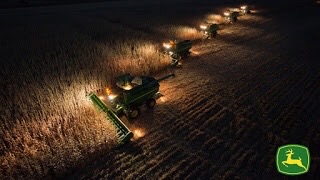Rapture: The Harvest of the Wheat
The Harvest as Portrayed in the Old Testament. The rapture, spoken of in the book of Revelation, is depicted as the harvesting of a wheat crop.
To be able to understand the rapture, one must also understand the harvesting of wheat as depicted in the Old Testament.
Now these things happened unto them (the Old Testament believers) by way of example; and they were written for our admonition, upon whom the end of the ages are come. (1 Cor. 10:11)
The Lord issued (through Moses) very specific instructions to His people about when and how they were to harvest their wheat crops. Undoubtedly these instructions were helpful agriculturally, but I earnestly believe that these Old Testament instructions were intended as much for the benefit of us, the New Testament believers.
Without them, the rapture remains nebulous; with them, the process of the rapture becomes clear.
Three times thou shalt keep a feast unto me in the year. The feast of unleavened bread shalt thou keep: seven days thou shalt eat unleavened bread, as I command thee, at the time appointed in the month Abib (for in it thou comest out of Egypt); none shall appear before me empty: and the feast of harvests, the first‑fruits of thy labors, which thou sowest in the field: and the feast of ingathering, at the and of the year, when thou gatherest in the labors out of the field. (Exod. 23:14‑16)
Three times in a year shall all thy males appear before Jehovah thy God in the place which he shall choose: in the feast of unleavened bread, and in the feast of weeks, and in the feast of tabernacles; and they shall not appear before Jehovah empty: (Deut. 16:16)
The Jewish people have three feasts that the Lord commanded them to keep. One of these feasts, the feast of unleavened bread, was kept as a memorial of the Exodus of the Jews from Egypt.
The other two feasts were related to the harvest.
We see from these sets of verses that the first harvest‑related feast was known as the feast of weeks but was also described as the feast of the #first‑fruits of the harvest.
The second of the harvest‑related feasts was known as the feast of tabernacles, but was also described as the feast of ingathering (of the rest of the harvest: the majority of the crop).
In the first month, on the fourteenth day of the month at even, is Jehovah's Passover. And on the fifteenth day of the same month is a feast of unleavened bread unto Jehovah: even days ye shall eat unleavened bread. (Lev. 23:6‑6)
The feast of unleavened bread was on the fifteenth day of the first month (at that time, Abib) of the Jewish calendar.
Seven weeks shalt thou number unto thee: from the time thou beginnest to put the sickle to the standing grain shalt thou begin to number seven weeks. And thou halt keep the feast of weeks unto Jehovah thy God with a tribute of a free‑will‑offering of thy hand, which thou halt give, according as Jehovah thy God blesseth thee: (Deut. 16:9‑10).
And ye shall count unto you from the morrow after the sabbath, from the day that ye brought the sheaf of the wave‑offering; seven Sabbaths shall there be complete: … Ye shall bring out of your habitations two wave‑loaves of two tenths parts of an ephah: they shall be of fine flour, they shall be baken with leaven, for first‑fruits unto Jehovah. (Lev. 23:16, 17)
I may be mistaken, but evidently the feast of weeks (first-fruits) was held on an indefinite date that was dependent on the time that the sickle was first put to the grain.
Thus the time of the feast of weeks (first-fruits) depended on the maturing of the crop. This is highly significant.
Also in the day of the first‑fruits, when ye offer a new meal‑offering unto Jehovah in your feast of weeks, ye shall have a holy convocation; ye shall do no servile work; (Num. 28:26)
The feast of weeks was the time when the first‑fruits of the crop were harvested.
What are the first‑fruits? In any crop, some fruits ripen before the majority of the rest of the crop. Thus, the feast of weeks, at which the first‑fruits (a free‑will offering) were presented, could not be held until the first fruits of the crop had matured. Again, this is highly significant.
Where were the first‑fruits taken?
Speak unto the children of Israel, and say unto them, When ye are come into the land which I give unto you, and shall reap the harvest thereof, then ye shall bring the sheaf of the first‑fruits of your harvest unto the priest: (Lev. 26:10)
The first of the first‑fruits of thy ground thou shalt bring unto the house of Jehovah thy God. (Exod. 34:261.
The first-fruits were taken to the house of the Lord. Again, this is highly significant.
Speak unto the children of Israel, saying, On the fifteenth day of this seventh month is the feast of tabernacles for seven days unto Jehovah. (Lev. 23:34)
The feast of tabernacles (ingathering), at which time the majority of the crop was harvested, took place in the seventh month of the Jewish calendar, beginning on the fifteenth day.
Evidently the feast of weeks (gathering of the first‑fruits) was for only one day, whereas the feast of tabernacles (the gathering of the majority of the crop) was for seven days.
Numerically speaking, we may say that the harvesting of the first‑fruits is characterized by suddenness; whereas ingathering, the harvest of the majority of the crop is characterized by completion.
Where was the majority of the crop taken?
Jehovah will command the blessing upon thee in thy barns. (Deut.28:8)
The general harvest was taken into the farmer's barn, not into the house of the Lord, as were the first‑fruits. Again, this is highly significant.
And when ye reap the harvest of your land, thou shalt not wholly reap the corners of thy field, neither shalt thou gather the gleaning of thy harvest: thou shalt leave them for the poor, and for the sojourner . . . (Lev. 23:22).
A small amount of the crop was left in the field.
In a harvest, gleanings are the parts of the crop that are still not ripe enough to be harvested. To the hungry poor, even unripe food was a blessing. Thus, the gleanings were a blessing for the people who were in Israel but not of Israel. These points are also significant.
1. The harvest of the crop is divided into three separate categories, which are harvested at three different times: The First-Fruits, the General Harvest of the majority of the crop, and the Gleanings.
2. The first-fruits are the part of the crop that matures prior to the majority of the crop, and are consequently harvested separately from, and prior to, the majority of the crop.
3. The first-fruits are taken to the house of the Lord, whereas the general harvest (the majority of the crop) is gathered into the farmer's barns.
At the end of the harvest, a small portion of the crop is still not mature and is still in the field, as a blessing for the hungry poor and the sojourner.
Jehovah will command the blessing upon thee in thy barns. (Deut.28:8)
The general harvest was taken into the farmer's barn, not into the house of the Lord, as were the first‑fruits. Again, this is highly significant.
And when ye reap the harvest of your land, thou shalt not wholly reap the corners of thy field, neither shalt thou gather the gleaning of thy harvest: thou shalt leave them for the poor, and for the sojourner . . . (Lev. 23:22).
A small amount of the crop was left in the field.
In a harvest, gleanings are the parts of the crop that are still not ripe enough to be harvested. To the hungry poor, even unripe food was a blessing. Thus, the gleanings were a blessing for the people who were in Israel but not of Israel. These points are also significant.
In summation, the points of the Old Testament harvest that are significant and necessary to an understanding of the rapture are as follows:
1. The harvest of the crop is divided into three separate categories, which are harvested at three different times: The First-Fruits, the General Harvest of the majority of the crop, and the Gleanings.
2. The first-fruits are the part of the crop that matures prior to the majority of the crop, and are consequently harvested separately from, and prior to, the majority of the crop.
3. The first-fruits are taken to the house of the Lord, whereas the general harvest (the majority of the crop) is gathered into the farmer's barns.
At the end of the harvest, a small portion of the crop is still not mature and is still in the field, as a blessing for the hungry poor and the sojourner.




Comments